Medical detox is a crucial step in the addiction recovery process. This procedure cleanses your body of harmful chemicals that ended up there from drug or alcohol use. The most common type of detox is one with 24-hour supervision and care from licensed medical professionals. However, ambulatory detox has proven to be another effective option for people who must tend to outside responsibilities. It’s also a relatively wallet-friendly choice for those on a budget.
Read more about the definition of ambulatory detox, how it is useful and how we can help you determine if this is the best course of action for you. Asking the right questions about your care will point you in the right direction.

What is Ambulatory Detox?
Ambulatory detox is another term for outpatient treatment. In ambulatory detox, patients can receive the addiction treatment they need during the day and return home in the evening. This is highly beneficial for people who have to go to work or school or take care of a child. Ambulatory detox has pretty much all of the amenities of inpatient treatment, without the residential portion. This program is best for people with mild to a moderate substance use disorder.
What to Expect in Ambulatory Detox
Ambulatory detox can be performed in one of two ways. Patients can either attend brief appointments scheduled at a clinic, or they attend day-long sessions at the said clinic. Ambulatory detox will typically include medication-assisted treatment; some individual, group, and family therapy appointments; and different forms of psychotherapies.
Some psychotherapies offered can include cognitive-behavioral therapy (CBT) and dialectical behavior therapy (DBT). These focus on people’s negative thoughts, emotions, and behaviors and help improve their relationships with others. Therapy is necessary after detox to change the way you think about drugs and alcohol. By learning healthy habits and routines, you’re more likely to stay sober for the long haul.
Although ambulatory detox offers more independence, this can also leave room for addiction triggers to creep in. These can include places where you used to take drugs and people with whom you used in the past. This is why you must have a stable support system at home when you leave daytime treatment.
Ambulatory Detox Placement Levels
There are two placement levels of ambulatory detox as established by the American Society of Addiction Medicine. There are a total of five levels of detox, but the first two strictly relate to outpatient treatment.
- Level I-D: Ambulatory Detoxification Without Extended Onsite Monitoring
- This is an organized outpatient service.
- You’re supervised by licensed and trained clinicians and attend regularly scheduled sessions.
- Your detox may be administered in a treatment facility, at home, or in an office setting.
- This should be offered under a strict set of medical protocols or procedures.
- Level II-D: Ambulatory Detoxification With Extended Onsite Monitoring
- Like Level I-D, this is also an organized outpatient service, but it’s a little more restrictive.
- This level of detox can be offered in all the settings of Level I-D except for your patient’s home.
- You’re still supervised by licensed clinicians and go to regular detox sessions.
- You’ll also be monitored by licensed nurses for several hours every day.
Benefits of Ambulatory Detox
There are several benefits to ambulatory detox. Review all of these, and then make an educated decision with your addiction specialist about the best form of detox for you.
- You can return home after treatment: If you live in a supportive environment with friends or family, it could be good for you to stay here while you attend ambulatory detox. Living at home while attending treatment can help you quickly adjust to living a sober lifestyle.
- You’ll most likely have medication to help you: FDA-approved medication is commonly used to mitigate painful withdrawal symptoms during detox.
- You’ll have a strong support network: Having your family and friends at your disposal can greatly help when you’re going through detox. Since ambulatory detox allows you to go home at your treatment, you’ll have immediate access to a supportive network of people.
- Ambulatory detox is cheaper than inpatient treatment: A large concern with addiction treatment is cost. If you don’t have insurance, this can make detox expenses even worse. You’ll be paying about 40% less for outpatient treatment than for inpatient since you’re eliminating an overnight stay at the facility.
- You’ll have a longer course of treatment, ensuring recovery: When you stay in a treatment program for a long time, you’ll be tapered off drugs or alcohol more gently. You can also stay in therapy longer. Health insurance providers are also likely to cover an extended treatment stay since it’s more economical.
Which Type of Detox is Right for Me?
The type of detox you need depends on several factors, such as the severity of addiction and the substance you’ve been using. If your addiction is more severe, you’ll most likely need inpatient or residential treatment. People with more mild addictions or substance use disorders can get by with an ambulatory detox program.
If you’ve relapsed or have an intense substance abuse problem, you’d be a better candidate for intensive outpatient or inpatient care. Inpatient treatment provides you with round-the-clock supervision and requires you to live at the rehab facility.
Make sure you consult with your addiction specialist so you can enroll in a program that’s tailored to your needs. You don’t want to have to go through treatment more than once if you can help it. Enlist advice from your friends and family as well.
Criteria for Determining Detox
According to the American Society of Addiction Medicine, there are six dimensions used to determine what type of detox you need:
- Acute Intoxication/Withdrawal Potential: This dimension explores your past and present experiences with substance abuse and withdrawal.
- Biomedical Conditions and Complications: This delves into your current physical condition as well as your medical history.
- Emotional, Behavioral, or Cognitive Conditions and Complications: Here, doctors look at your mental health issues, emotions, and thoughts.
- Readiness to Change: This will look at whether you’re willing and ready to change your destructive habits.
- Relapse, Continued Use, or Continued Problem Potential: Medical staff looks at your past issues with relapse and your continued use of a substance.
- Recovery/Living Environment: In this dimension, we’ll explore the safety of your current living situation as well as the people around you every day.
Looking at each dimension will help our staff create a detailed assessment of your substance misuse. This will also help us figure out the best course of detox and addiction treatment for you.
Should I Detox At Home?
You should never try to detox at home. Since withdrawal symptoms can be painful and potentially fatal, you should always have a medical professional present during detox. LA Detox staff are trained in this procedure and know how to handle these symptoms.
Recovering from alcohol addiction can produce a serious set of withdrawal symptoms called delirium tremens (DTs). You’ll experience severe confusion, agitation, restlessness, and hallucinations. If you’re by yourself when you go through DTs, you could die without help. Although DTs really only happen in long-term or heavy drinkers, they’re still potentially deadly symptoms to watch out for.
Begin Ambulatory Detox Today
Although detox is important for addiction recovery, you’ll still need plenty of therapy and aftercare to achieve full sobriety. Our staff at LA Detox can direct you toward several recovery programs, whether you’ve completed ambulatory detox or inpatient treatment. Don’t wait one more day! Contact us today to speak with a trusted representative or fill out the insurance verification form to get started towards detox. Your time has come to recover from addiction.
References:
https://bergandgroup.com/ambulatory-detox-defined/







